One of the easiest fish to target and catch is the catfish, even when it comes to hunting for those big blue catfish that grow to rather epic sizes. There are two reasons why: catfish are plentiful, and most of the time they’re also hungry. Very hungry. With some basic know-how regarding rigging and where you’re likely to find catfish, your chances of getting bites are tremendous — especially when compared to some of the finickier fishes in the water.
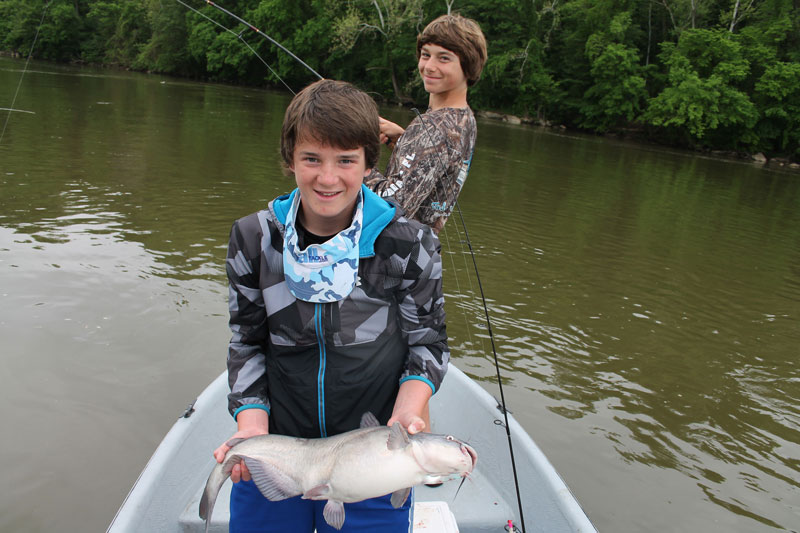
What are Catfish?
Hey, even the newest anglers among us know what a catfish is. We should, however, differentiate between the species.
Blue Catfish

This species is among the most prolific in Chesapeake tributaries, and in some rivers, represents up to three-quarters of the biomass. It’s present in many of the larger lakes and reservoirs in the Mid-Atlantic region, as well. They get utterly huge, and hooking a 100-pounder is not outside the realm of possibility. It’s also an invasive species which threatens the healthy populations of many native fish in some waterways. So they’re a great fish to target, take home, and eat. (Note that smaller cats in the 30 inch and under range are the best ones to eat and in some waterways larger fish may carry consumption advisories).
Channel Catfish
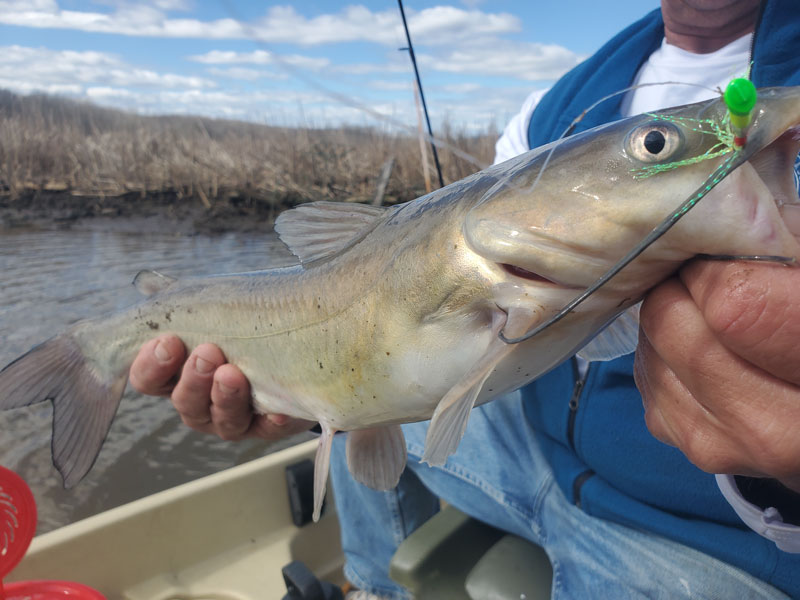
Channel cats are also found in huge numbers in many waterways. They don’t grow quite as large but they fight great and are also awesome on the plate. When you’re fishing for channel and blue catfish, in many areas you’ll catch a mix. They tend to live in similar areas and hit all the same baits, so it’s common to encounter both species at the same time.
Other Catfish
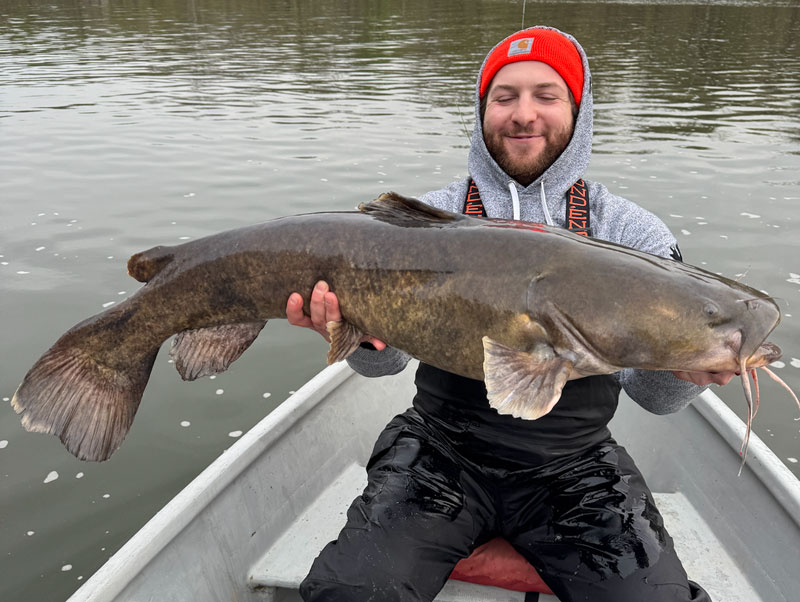
Along with these two prime targets there are several more types of catfish found in the region including: flatheads (another invasive), which are usually found in rocky river areas; bullhead catfish, a native species that grows to about three pounds; and white catfish, another native species which reaches about seven pounds. All of these are edible and many people consider them great to eat, but most anglers targeting fish for dinner are apt to shoot for blues and channels.
Record Catfish
In the Chesapeake Bay and Mid-Atlantic region the record catfish are:
- Blue Catfish – A shocking 143-pound blue catfish was caught in 2011 at Buggs Island Lake in Virginia. In tidal waters, several blue catfish topping 100 pounds have been recorded.
- Channel Catfish – The biggest channel cat also comes from Virginia waters, with a 32-pounder caught in Lake Chesdin and a 31.8-pounder caught in the Rappahannock River.
Catfish Seasons
This will be a short section, folks! Thankfully, both blue and channel catfish feed throughout the year. Even in the middle of the winter you can enjoy angling success when you target catfish. One caveat: when water temperatures drop below about 38 degrees, the bite can slow down quite a bit.
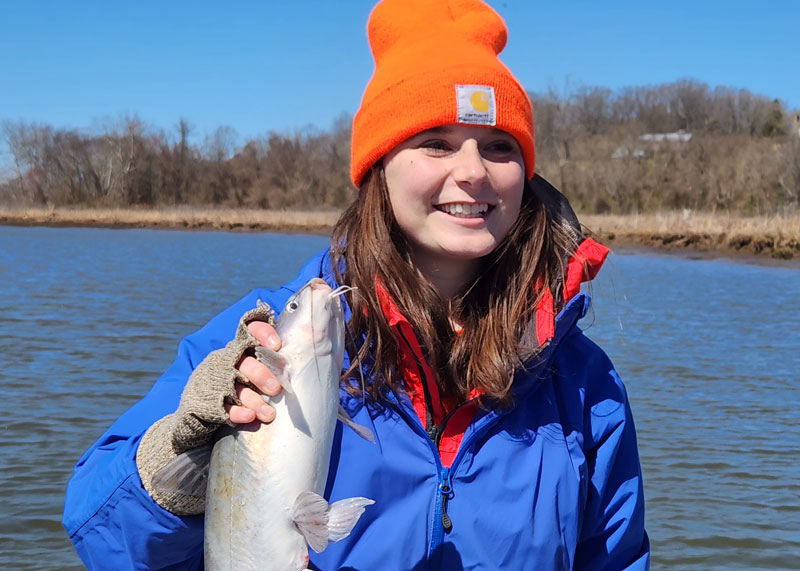
Catfish Regulations
Here’s another shortie — in the region there aren’t any size restrictions on blue or channel catfish, but Maryland limits the take of channel catfish to five per day. Virginia limits the take of blues and channels to 20 per day but there are some specific exceptions and lakes limiting the take of fish over 32 inches; check the Creel Limit regs for the specifics.
How to Catch Catfish
Good news, people: as far as fishing goes, this is going to be easy! All you’ll need to do is locate a shoreline spot where you can cast to relatively deep water, or park your boat along a channel edge or hole. Fish will usually be concentrated along the drop-offs in most of the Chesapeake Bay tributary tidal areas. In upriver areas and lakes the same is true, but having structure will often attract the largest specimens. Holes with a submerged tree, for example, can represent prime habitat that gets taken over by the biggest fish in town.
Remember that depth is relative. You can be fishing in a large creek averaging three or four feet with a six-foot channel, and fishing in the channel may well be the best move. If there’s a creek averaging 10 feet with a 20-foot channel, again, the channel will likely be a good bet. But there may well be more catfish to catch in the shallower creek than in the deeper one.
Best Bait for Catfish Fishing
It’s often said that catfish will eat anything, and this is more or less true. However, some baits do work better than others. The standard offering is cut fish (usually gizzard shad or menhaden in tidal waters). However, many catfish sharpies feel that live baits work even better. In tidal waters white perch and bull minnow are commonly used and in freshwater, live sunfish or crappie are considered top offerings.
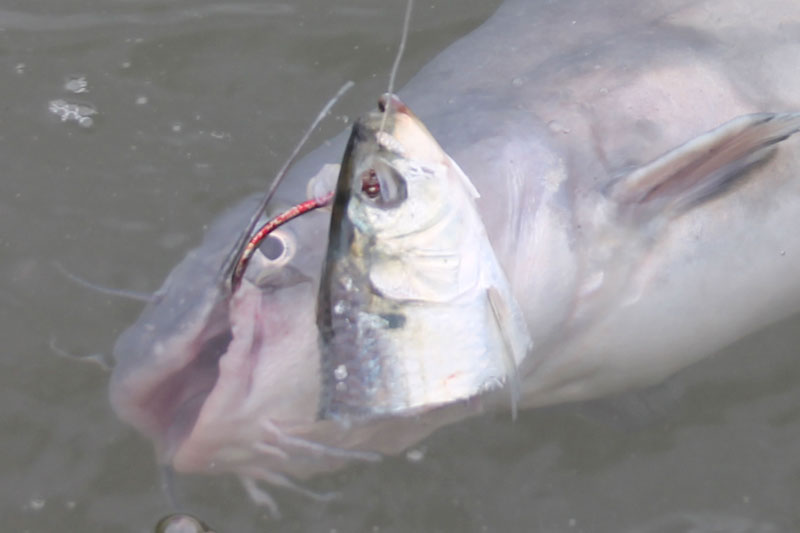
Some other common baits include chicken breast strips and chicken livers. Both work quite well right out of the grocery store, which makes procuring good bait easy even for those who may not live near a convenient tackle shop.
Fishing Tip: Cool on Cats
Many anglers believe that catfish baits, particularly strips of raw chicken, catch a lot more catfish when they’re prepped with (of all things) Kool-Aid. They’ll take cherry, strawberry, or grape Kool-Aid and add it to a zipper-lock bag, then add the chicken strips, and shake the bag around to evenly distribute the Kool Aid and the bait. Then, the bag is left in the refrigerator to percolate overnight. Allegedly the sweet, strong Kool-Aid gives a serious boost in the bite department.
Best Gear for Catfish Fishing
Rig up a rod stout enough to handle anything you hope to land (medium to medium-heavy spinning gear with 20- to 30-pound test should be about right for most folks) with a weighted rig that will keep your bait on or near bottom. Top-and-bottom rigs will work, but a fishfinder-style rig or putting on an inline egg sinker above the leader works fine, as does simply adding a few split-shot to rigs used in relatively shallow waters with little or no current.
If you're looking for a rod and reel that's ideal for catfish, delivers a great bang for the buck, and offers some special features (that are uber-cool!!) check out this gear review video we recently shot on a Piscifun catfish rig - it's pretty darn nifty.
If you decide to order one of these from Piscifun enter code FM18 on check-out - you'll get a discount (woohoo!) and we'll get a sliver of the action (which helps us keep the wheels turning, so thanks!)
The business end of your rig should have three or four feet of 30- to 50-pound class monofilament leader, with an 8/0 to 10/0 circle hook tied to the end. Circle hooks work particularly well on catfish, and if you use J hooks you’ll spend a good deal of time digging them out of fish that swallow the bait all the way down.
Simple? You bet. And that’s one of the great things about fishing for catfish—you don’t need a bunch of expensive gear, and basic knowledge is enough to get into the game. So the next time opportunity comes knocking, consider going on a whisker hunt.
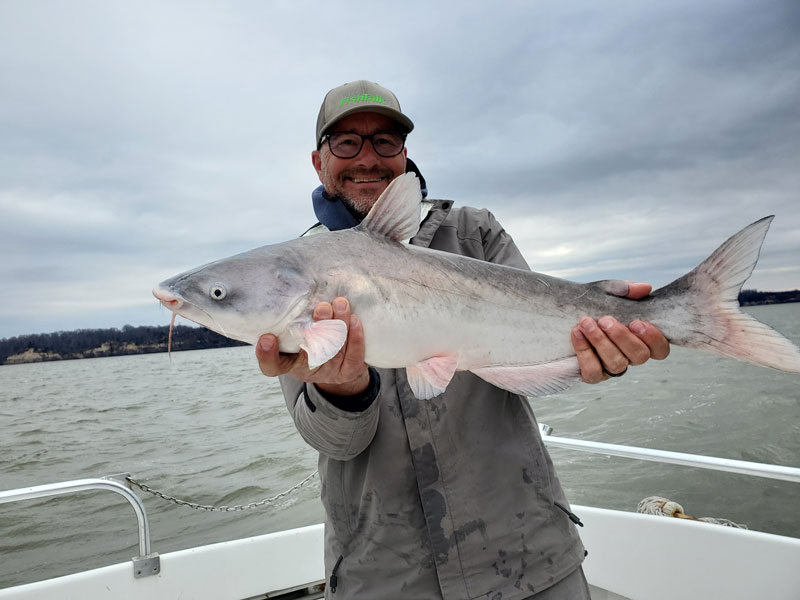
Catfish Fishing Hotspots
As we mentioned, blue and channel cats are well-established in a huge number of waterways throughout the region and simply going to the one closest to home is likely to result in success. That said, if you want to try a prime area here are some top hotspots to head for listed from north to south.
East Side
Elk River and the C&D Canal – These waterways hold catfish galore. Most are channel cats but blue cats have been constantly expanding through these waters and sooner or later will likely surpass the channel cats in both numbers and size.
Choptank River near Denton, MD – This section of the Choptank has had a strong population of channel catfish for years, and now plenty of blue cats are in the mix as well. Due to their relatively recent arrival you won’t find gigantic specimens but you will enjoy nonstop action.
Marshyhope Creek – The Marshyhope is a small body of water, but it’s utterly jam-packed with catfish. Look for current-scoured holes on the outside of bends, drop fish chunks to the bottom, and hold on tight. As with the Choptank, look for numbers here as opposed to size as the blue cats are relative newcomers.
West Side
Susquehanna River between Port Deposit and Havre De Grace – Anchor up anywhere within sight of the Route 95 bridge over a channel edge or hole, and you may well catch catfish until your arms ache. Although the blues here aren’t as large as some of the flatheads (yet) there are 30-plus-pounders to be caught and the number of eating-sized catfish is off the hook.
Potomac River in and south of Washington, DC – From the banks of Georgetown clear down to the 301 bridge, blue catfish rule the roost. Most will be eating size but there are some pushing the 80-pound mark and even more, and the numbers are utterly astonishing — during the 2020 Fish For a Cure, Team FishTalk racked up well over 800 inches of blue cats in a morning of fishing. Channel catfish are present, too, but due to the blue catfish’s overwhelming numbers you’ll catch them 10-to-one.
Rappahannock River from Port Royal to Leedstown – This stretch of the Rap is inundated with blue cats and although channels live here too, the situation is similar to that of the Potomac. Gizzard shad is the preferred bait by most anglers wetting their lines here.
The Pamonkey and Mattaponi – Like the Marshyhope across the Bay, these rivers are small but mighty when it comes to fishing for catfish. Many hit the 30-pound mark and 80-pounders have been produced here.
The James River from Claremont up – The James is the king of trophy blue catfish fishing, and it’s also where it all began. First released here in the 1970s, blue cats topping 100 pounds have been documented in the James and this river is responsible for more 50-plus-pounders than any other single waterway in the region.
Lakes
Lake Chesdin – Channel catfish are the dominant whiskered species here, as evidenced by the state record catch. Fish like that are a rarity, though, and most anglers will come here because you can catch great numbers of eating-sized fish in the five-pound range.
Buggs Island Lake - This lake is known for its monster blue cats, and this is where the epic 143-pound record fish came from. Not only did that fish set the Virginia record, but it’s also the world record blue cat. Live sunfish or crappie are favored by the trophy hunters here, and night fishing over underwater points and humps adjacent to the channels is a popular tactic.
- For more advanced information, also see:
Tactics for Monster Blue Catfish
Shoreline Fishing for Trophy Blue Catfish on the Potomac
Editor's note: This article was originally published in June of 2023 and was last updated in August of 2025.